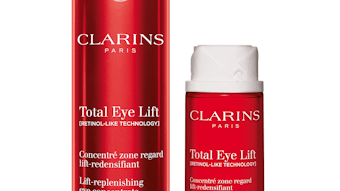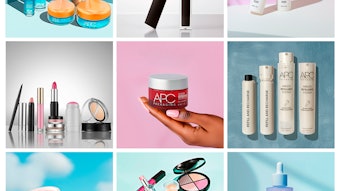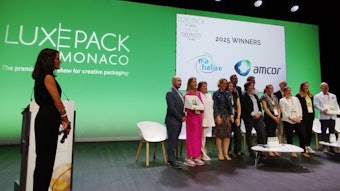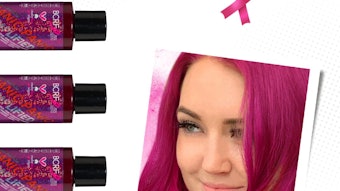- Effective utilization of secondary packaging is a key way to be visually engaging.
- When developing secondary packaging for a brand, you want to make sure it will contribute ROI.
- Secondary packaging is often used to impart a more luxury experience with a product.
- When a brand is positioned as eco-friendly, ensure the secondary packaging serves a purpose.
As consumers shop more online and spend less time perusing the shelves at drug stores and counters at department stores, the need to engage on a visual level is more important than ever for beauty. And a key way to be visually engaging is utilizing secondary packaging.
“In general, we all respond to a lot of the same visual cues when we’re shopping. Whether or not they fuel our purchases is a different matter, but gaining attention is at least half the battle,” says Jonathan Dudlak, general manager, Chicago Paper Tube & Can Company. “Secondary packaging gives designers the opportunity to work in a separate medium dedicated solely to engaging the buyer. Whether this is through something artistic like the use of novel materials, shapes and finishes, or through something practical like a re-purposeable container, it’s a whole new opportunity to make that connection.”
Petra Strand, founder and creator of the Pixi beauty brand, explains that for her, secondary packaging is really about storytelling. “It communicates the DNA of the brand,” she says. “In a self-service environment, it is the only place I can talk about all the benefits of the product and speak directly to customers.”
Describing Pixi’s own efforts in communication-via-secondary-packaging, Strand notes, “Ours is pastel green with bronze printing. Green is soothing and tells us it’s good for your skin [while] the bronze adds a luxe prestige feel.”
The Need for Secondary
Clearly, secondary packaging can offer quite a lot to a beauty brand. In fact, Dudlak says, “Secondary packaging is what does the selling at retail. It establishes the brand image and helps distinguish the product from what can sometimes be a dizzying array of competitors, which is why it’s so important to have a unique presentation. This is especially true when it comes to health and beauty offerings, where there are often several potential purchase options.”
Charles Hays, vice president of sales and marketing for Printex Packaging, says that secondary packaging not only helps maintain retail space but also gives more on-product space. “It becomes complicated to get all of the product information on bottles, jars and other primary packages,” he notes.
And Suzan Kerston, executive vice president, Bert-Co, agrees that this packaging element has a lot to do. “The secondary package has a big job. [It] really needs to get the product noticed at retail and drive home the brand’s message. Of course it has to protect the product, but secondary packaging can also enhance the product and make it more desirable. The package can inform and educate the buyer and really close the deal. The ‘out-of-box experience’ should reinforce the shopper’s buying decision and bring them back for more,” she explains.
How is secondary packaging grabbing this retail attention and making these consumer connections? “Eye-catching designs are the first step to consumer engagement. Consumers initially engage through sight, singling out products they are interested in at retail before learning more about them,” says Don Droppo, Jr., president and CEO, Curtis Packaging.
However, he also outlines further opportunities that secondary packaging offers to help brands stand out on shelves. “Products can be differentiated through both innovative structural design and printed graphics and effects,” he says. “But what is sometimes overlooked is the third dimension of the design—touch. The weight of the product, the rigidity of the board, embossing, tactile and soft touch coatings, all these elements add up to a package consumers will be more engaged with and hold onto longer once they pick it up.”
The Inner Workings
Getting a product into the consumer’s hands is key, but it’s not all secondary packaging can do. Secondary packaging can also assist in the product making it safely to retail shelves. “It certainly serves functional purposes, as well, such as protecting a fragile primary during shipping and handling, tamper evidence and prevention, and adding additional area to convey product information, instructions and marketing messages that might not be doable on a primary package,” acknowledges Dudlak, and Strand also notes, “It protects the contents if the inner packaging is clear [as] many natural pigments are light sensitive. It lasts longer on the shelves in-store and travels safer so there is not as much damage.”
Dudlak explains, “On the execution side, creating a secondary package that works for the primary can be rather involved, as molded plastic and glass primary containers often have complex shapes that can be challenging to contain and control in just the right way. The product needs to survive pack-out and shipment and still look good when the customer opens the secondary. We generally have to do a lot of engineering and trials here to devise custom solutions for all the different products we encounter.” And while devising a sound package may take some time, it’s worth it to help contribute to that experience that a consumer has with your brand.
Of course, another reason many brands shy away from secondary packaging is monetary. “The additional cost is always the first hurdle to get over,” says Hays. “Then it becomes a design/branding message issue, trying to keep consistent with brand and design of the primary package to make sure the secondary package holds this up as well. We resolve this by asking questions about the product and what the retailer/product objective is on the shelf for the product. The main answer is always, ‘I want the product to sell.’ We try to look for something that will give the consumer a visual and interactive experience. Package performance is critical on the shelf and after it reaches the consumer, so we try to see what can be developed specific to this as well.”
Basically, when developing secondary packaging for a brand, you want to make sure it’s worthwhile and will contribute ROI.
A Better Experience
Investing in secondary packaging, aside from being engaging and ensuring better product safety, can also lend a beauty product a more prestige feel. Hays notes that secondary packaging can be used in the skin care, hair care, nail care and fragrance segments, among others, but it is also seen when brands want to help impart a more luxury experience with a product.
“Secondary packaging is utilized more in prestige products, but there are lots of opportunities in every segment of the business,” says Kerston. “Usually it’s a cost decision whether to include a secondary package. But when you think of all the benefits of a secondary package, there are lots of products that could benefit from better shelf presence, which translates to sales—and who doesn’t want more sales?”
Strand also says that the idea that secondary packaging is only used in prestige is “getting blurred and everybody is doing everything. More and more retailers are mixing low price points and higher price points brands in same departments, just like European cosmetic retailers and specialty stores have done for a long time. [And this is] more true to how women shop—we have some expensive products mixed with some lower price point product in our makeup bags at all times.”
“Opportunities are in all of the segments; it is a matter of economics and objective for the brands,” Hays says.
But what if eco-friendliness is one of those objectives? Secondary packaging is often a target here, but that means brands need to ensure that their secondary packaging serves a purpose. “What people often don’t realize is that increased product loss due to preventable damage winds up having a much greater footprint than protective packaging would have,” Droppo says. “We address environmental concerns by working to make our production process and our designs as efficient and low impact as possible, while still allowing the packaging to perform its necessary functions.”
Dudlak concurs, saying, “People are still concerned with overpackaging, from both cost- and eco-conscious standpoints, so designers are all trying to do more with less. I think as a result of this, we’re seeing more use of color and coatings in our packaging lately to add dimension to products with simple, clean structural lines rather than adding additional adornments. The ‘earthy’ look that was abundant a couple years back has died down some, but will always be in style as a novel presentation for products that are typically not eco-friendly.”
Hays says it’s important to understand, “Sustainability is always part of the discussion with secondary packaging. More retailers are asking for less packaging, so in the design of a secondary package, the less material the better.”
While it’s very important to be sure you’ve thought through all your packaging plans to ensure they make sense for your product, if secondary packaging is something that helps give your brand the experience your target consumers are seeking, it can be invaluable. “We all know it’s crowded at retail. So a package with an amazing great look that gets noticed has done its job,” says Kerston. “A great package can seamlessly integrate the brand’s message and help the shopper make the decision to own it. Vivid crisp graphics, metallic details, texture, shape, unique materials can work together or alone to create a feeling that connects with the shopper. And adding texture to a package is one of the most engaging techniques we’ve seen. If the shopper picks up the package, we’re halfway home.”
Ideas and Innovations
There are lots of new options and opportunities to help products make that leap from shelf to shopping basket using secondary packaging. For example, “Color that talks to you and tells the story of the product, brand and the style, and you should be able to look at the packaging and understand the product inside—and even the makeup style the brand represents,” Strand explains. “I like when brands add the element of fashion [to packaging], and brands that do something different. After all, makeup is an extension of fashion.”
To give products a fashionable twist, Hays notes, “Round, oval [and] curvy seem to be the latest shapes.” And Droppo notes, “Hot-stamping, embossing and inside printing are more popular than ever, and brands are constantly pushing the boundaries on color in their designs. On the flip side, we are also seeing more requests for an uncoated, natural-looking board than we have in the past.”
Echoing a trend mentioned previously, Droppo comments, “Touch is definitely in. Soft touch board and coatings and raised, tactile coatings are both hot.” And Kerston says, “We see texture produced with coatings, embossing, and unique materials. Some texture can be done easily with an in-line coating, like our Vista Texture. The sky is the limit as far as the patterns in texture that can be incorporated. Enticing a shopper to touch the package to feel the texture on a package is huge.”
Another option is customization. “Innovative products are enabling more and better customization. For example, registered holographics allow designers to brand not only the printing on top of the substrate but the actual substrate itself,” says Droppo. “Also, new digital coating technology from Scodix allows for precise applications of high gloss UV coating with varying thicknesses.”
And getting into new beauty segments also helps encourage new ideas and opportunities. “We have recently made some inroads with our paper compacts for makeup products like foundation and blush, which are traditionally lower-cost items that come in standard glass or plastic packaging,” says Dudlak. “Paper isn’t directly competitive with most of these options on cost, but the environmental profile is so attractive that eco-conscious formulators use it for select products.”
Dudlak also notes that transforming products via secondary packaging is something he’s seeing more of. “Most of our innovations are in turning secondary packaging into primary packaging, like directly packaging cosmetics in paperboard alternatives to plastic, glass and metal. We have a whole line of paper jars, dispensers, compacts, and samplers and testers dedicated to this specific purpose, and the response has been excellent,” he explains.
Kerston also comments, “Innovations are important to give value to new products. We help create new structures, new coatings, or a new process of application, or a combination in a way that hasn’t been seen before regularly. It’s one of the things that makes this business fun and hopefully bring new fresh looks to retail that keeps the shopper enticed to pick up the package and say ‘What’s that?’ We have a new coating called ‘Tire Tread’ that’s not on shelf yet; it’s a raised coating that is very dull black. We also have a new look we call ‘Pearl Waves’ where there is a hint of a holographic look. And we have a new innovative closure feature for a folding carton that clicks when you close the box but doesn’t use any added closures like Velcro or magnets. We call it ‘Sher-loc.’”
Obviously, secondary packaging can offer lots of fun, engaging options for beauty products. From an enhanced experience to a more prestige feel to eco-friendly options, secondary packaging aims to bring better value to a beauty product, and Strand sums this up by saying that when Pixi uses secondary packaging, the aim is always “to add value to the product due to the packaging.”









